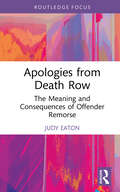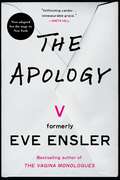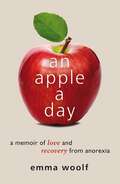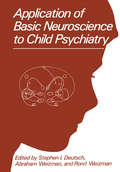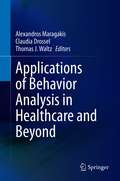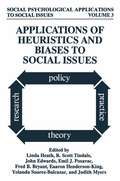- Table View
- List View
Apologies and the Legacy of Abuse of Children in 'Care': International Perspectives (Palgrave Studies in the History of Childhood)
by Johanna Sk�ld Shurlee SwainThis book positions inquiries into the historical abuse of children in care within the context of transitional justice. It examines investigation, apology and redress processes across a range of Western nations to trace the growth of the movement, national particularities and the impact of the work on professionals involved.
Apologies from Death Row: The Meaning and Consequences of Offender Remorse (Routledge Studies in Criminal Behaviour)
by Judy EatonApologies from Death Row explores the notion of remorse, apologies, and forgiveness within the context of capital punishment in the United States, through the final words of offenders on death row, and the covictims’ responses to them in their statements to the press after witnessing the execution. The book demonstrates that there is evidence that some offenders on death row are truly remorseful and that some of the family members of their victims could benefit from this remorse, but that this is unlikely in the current system of capital punishment. Drawing from the fields of criminology, psychology, and sociology, the book begins with a theoretically informed introduction to the concepts of remorse and forgiveness, followed by an exploration of apology and forgiveness specifically in the context of capital punishment. It discusses how some initiatives within the criminal justice system, such as apology laws and restorative justice programmes, are being used to make it easier for offenders to apologize to their victims. Offenders on death row are considered, addressing why they might or might not apologize, and whether they are even capable of showing true remorse. The book then considers the family members of their victims ("covictims"), addressing whether they benefit from hearing the offender express remorse and witnessing the execution, and whether forgiveness is possible in this context. Evidence to support the arguments presented in the book come from the offenders’ final words and the covictims’ responses to them in their statements to the press. The book dispels two common myths about the death penalty. First, it shows that offenders on death row are not simply "monsters" who are incapable of understanding the severity of their crimes. Second, it provides evidence that, despite the popular belief that the death penalty is necessary in order to provide closure for the victims’ family members, it may actually have the opposite effect. The family members’ statements to the press after witnessing the execution contain more negative themes like anger and disappointment than positive themes like closure and peace. The book concludes with a discussion of the implications this has for systems of justice in general, and how a better understanding of the emotional state of offenders can help both victims and offenders. Apologies from Death Row will be of great interest to students and scholars of Criminology, Psychology, and Sociology.
Apologies from Death Row: The Meaning and Consequences of Offender Remorse (Routledge Studies in Criminal Behaviour)
by Judy EatonApologies from Death Row explores the notion of remorse, apologies, and forgiveness within the context of capital punishment in the United States, through the final words of offenders on death row, and the covictims’ responses to them in their statements to the press after witnessing the execution. The book demonstrates that there is evidence that some offenders on death row are truly remorseful and that some of the family members of their victims could benefit from this remorse, but that this is unlikely in the current system of capital punishment. Drawing from the fields of criminology, psychology, and sociology, the book begins with a theoretically informed introduction to the concepts of remorse and forgiveness, followed by an exploration of apology and forgiveness specifically in the context of capital punishment. It discusses how some initiatives within the criminal justice system, such as apology laws and restorative justice programmes, are being used to make it easier for offenders to apologize to their victims. Offenders on death row are considered, addressing why they might or might not apologize, and whether they are even capable of showing true remorse. The book then considers the family members of their victims ("covictims"), addressing whether they benefit from hearing the offender express remorse and witnessing the execution, and whether forgiveness is possible in this context. Evidence to support the arguments presented in the book come from the offenders’ final words and the covictims’ responses to them in their statements to the press. The book dispels two common myths about the death penalty. First, it shows that offenders on death row are not simply "monsters" who are incapable of understanding the severity of their crimes. Second, it provides evidence that, despite the popular belief that the death penalty is necessary in order to provide closure for the victims’ family members, it may actually have the opposite effect. The family members’ statements to the press after witnessing the execution contain more negative themes like anger and disappointment than positive themes like closure and peace. The book concludes with a discussion of the implications this has for systems of justice in general, and how a better understanding of the emotional state of offenders can help both victims and offenders. Apologies from Death Row will be of great interest to students and scholars of Criminology, Psychology, and Sociology.
The Apology
by Eve EnslerFrom Eve Ensler, author of one of the most influential works of the twentieth century--The Vagina Monologues--and one of Newsweek's "150 Women Who Changed the World," comes a powerful, life-changing examination of abuse and atonement. Like millions of women, Eve Ensler has been waiting much of her lifetime for an apology. Sexually and physically abused by her father, Eve has struggled her whole life from this betrayal, longing for an honest reckoning from a man who is long dead. After years of work as an anti-violence activist, she decided she would wait no longer; an apology could be imagined, by her, for her, to her. The Apology, written by Eve from her father's point of view in the words she longed to hear, attempts to transform the abuse she suffered with unflinching truthfulness, compassion, and an expansive vision for the future. Through The Apology Eve has set out to provide a new way for herself and a possible road for others, so that survivors of abuse may finally envision how to be free. She grapples with questions she has sought answers to since she first realized the impact of her father's abuse on her life: How do we offer a doorway rather than a locked cell? How do we move from humiliation to revelation, from curtailing behavior to changing it, from condemning perpetrators to calling them to reckoning? What will it take for abusers to genuinely apologize? Remarkable and original, The Apology is an acutely transformational look at how, from the wounds of sexual abuse, we can begin to re-emerge and heal. It is revolutionary, asking everything of each of us: courage, honesty, and forgiveness.
Apophatic Elements in the Theory and Practice of Psychoanalysis: Pseudo-Dionysius and C.G. Jung (Research In Analytical Psychology And Jungian Studies)
by David HendersonHow can the psychotherapist think about not knowing? Is psychoanalysis a contemplative practice? This book explores the possibility that there are resources in philosophy and theology which can help psychoanalysts and psychotherapists think more clearly about the unknown and the unknowable. The book applies the lens of apophasis to psychoanalysis,
Apophatic Elements in the Theory and Practice of Psychoanalysis: Pseudo-Dionysius and C.G. Jung
by David HendersonHow can the psychotherapist think about not knowing? Is psychoanalysis a contemplative practice? This book explores the possibility that there are resources in philosophy and theology which can help psychoanalysts and psychotherapists think more clearly about the unknown and the unknowable. The book applies the lens of apophasis to psychoanalysis,
APOS Theory: A Framework for Research and Curriculum Development in Mathematics Education
by Ilana Arnon Jim Cottrill Ed Dubinsky Asuman Oktaç Solange Roa Fuentes Maria Trigueros Kirk WellerIn spite of the fact that APOS Theory has been used extensively in numerous scholarly publications, in the design of textbooks, and in teaching practice, there is no single references that contains all the relevant information about its components, and provides guidance about its application. The goal of this book is to present the main elements of APOS theory. It should be useful for researchers who work with, or would like to learn more about, this theoretical approach, people who are interested in the way which mathematical conceptions are constructed according to this theory, Mathematics Education researchers, graduate students in Mathematics Education, and Mathematics instructors.
Appearance Anxiety: A Guide to Understanding Body Dysmorphic Disorder for Young People, Families and Professionals
by The National ServiceThe first book for teens that explains the causes and impact of body dysmorphic disorder (BDD). The book is interspersed with accounts and artwork from young people with BDD, along with perspectives of their families. BDD is a debilitating mental health disorder, and this book gives advice on treatment including CBT and medication, and shows where to get help.It increases awareness, provides solidarity for people with BDD, and alerts others to key signs and symptoms so they can prevent further suffering. It also includes a short section for families and professionals on what they can do to help, making this the go-to book for professionals and families to recommend to teens, as well an invaluable resource for young people themselves.
Appetite: Sex, Touch, and Desire in Women with Anorexia
by Melissa A. FabelloThe first comprehensive resource on anorexia and women’s sexuality in the world, this book presents a model for understanding sexuality as complex with interconnected factors, and how anorexia interacts with the varied components of one’s sexuality. Challenging the limiting views of sexuality that research on women with anorexia and sex has yielded, Dr. Fabello centers real women’s narratives to explore the various ways in which this population wrestles with sexual health, violence, intimacy, identity, and more. Included is unprecedented research on how women’s level of desire for sensual touch interacts with body image, body perception, and a unique need for sexual autonomy. Written in an honest voice, Appetite bridges the gap between academia and practicality, using grounded language that appeals to professionals and survivors alike.
Appetite: Sex, Touch, and Desire in Women with Anorexia
by Melissa A. FabelloThe first comprehensive resource on anorexia and women’s sexuality in the world, this book presents a model for understanding sexuality as complex with interconnected factors, and how anorexia interacts with the varied components of one’s sexuality. Challenging the limiting views of sexuality that research on women with anorexia and sex has yielded, Dr. Fabello centers real women’s narratives to explore the various ways in which this population wrestles with sexual health, violence, intimacy, identity, and more. Included is unprecedented research on how women’s level of desire for sensual touch interacts with body image, body perception, and a unique need for sexual autonomy. Written in an honest voice, Appetite bridges the gap between academia and practicality, using grounded language that appeals to professionals and survivors alike.
An Apple a Day: A Memoir of Love and Recovery from Anorexia
by Emma WoolfHaving met the man of her dreams (and wanting a baby together), Emma Woolf embarked on the hardest struggle of her life: to beat anorexia. At 32 years of age, she was functioning on an apple a day. This life-affirming true story is essential reading for anyone affected by eating disorders, and anyone interested in health and social issues.
Application of Basic Neuroscience to Child Psychiatry
by Stephen I. Deutsch, Abraham Weizman and Ronit WeizmanThe idea for this book developed during the course of several discussions among the editors while we were working together as staff scientists in the laboratories of the Clinical Neuro science Branch of the National Institute of Mental Health. It was a happy coincidence that the three of us, child psychiatrists with predominantly clinical interests, selected a collaborative bench research project involving neurotransmitter receptor characterization and regulation. We appreciated the relevance of our work to child psychiatry and wished for a forum to share the excitement we enjoyed in the laboratory with our clinical colleagues. Moreover, it seemed to us that much of the pharmacological research in child psychiatry proceeded on an empirical basis, often without a compelling neurochemical rationale. This could reflect the paucity of neurochemical data that exists in child psychiatry and the very limited understanding of the pathophysiology in most psychiatric disorders that occur in childhood. Also, we bemoaned the fact that there was a virtual absence of meaningful interchange between clinical investigators in child psychiatry and their colleagues in the neurosciences. We believed that an edited book appealing to clinicians and basic scientists could serve as an initial effort to foster interchange between them. The editors wish to emphasize that this book is viewed as only a beginning in the process of interchange that must take place.
Applications of Behavior Analysis in Healthcare and Beyond
by Alexandros Maragakis Claudia Drossel Thomas J. WaltzThis timely volume explores the multiple domains where Behavior Analysts can provide meaningful assessment and interventions. Selecting clinical areas in which behavior analysts already are active, chapters will describe unique features of the setting as well as the skills and competencies needed to practice in these areas. While providers of behavior analytic services have substantially increased in number, the field of behavior analysis itself has narrowed. Reimbursement policies and name recognition as a treatment specific to autism have raised concerns that other areas where it is helpful, such as behavioral gerontology or integrated behavioral health, will be de-emphasized. This volume aims to promote workforce development and support broad behavior analytic training, considering the Behavior Analyst Certification Board’s 5th edition task list (effective in 2020).
Applications of Cognitive Psychology: Problem Solving, Education, and Computing
by Dale E. Berger Kathy Pezdek William P. BanksPublished in the year 1986, Applications of Cognitive Psychology is a valuable contribution to the field of Cognitive Psychology.
Applications of Cognitive Psychology: Problem Solving, Education, and Computing
by Dale E. Berger, Kathy Pezdek, and William P. BanksPublished in the year 1986, Applications of Cognitive Psychology is a valuable contribution to the field of Cognitive Psychology.
Applications of Conditioning Theory (Psychology Revivals)
by Graham DaveyThe area of applied psychology known as behaviour modification or behaviour therapy had progressed remarkably in the ten years, prior to publication. Illustrative of this progress is the variety of therapeutic and behaviour management techniques now available to the applied psychologist. This volume, originally published in 1981, describes some of the important characteristics of this development, and in particular, the relationship between behaviour change techniques and the principles of conditioning theory that generated them. This brief gives rise to three main themes. First, the book describes some of the reasons underlying the adoption of the conditioning paradigm and the epistemological advantages of the paradigm for behaviour modification. Second, a number of chapters discuss the current trends in specific areas of applied psychology where conditioning principles play an important heuristic role. These chapters deal with the uses made of conditioning theory in the areas of mental handicap, psychiatric therapy, work organizations, and the treatment of brain injury. Third, later chapters discuss some of the more recent theoretical developments in the field of behaviour modification/therapy, in particular the drift from strict behaviouristic applications of conditioning principles to more cognitive ones.
Applications of Conditioning Theory (Psychology Revivals)
by Graham DaveyThe area of applied psychology known as behaviour modification or behaviour therapy had progressed remarkably in the ten years, prior to publication. Illustrative of this progress is the variety of therapeutic and behaviour management techniques now available to the applied psychologist. This volume, originally published in 1981, describes some of the important characteristics of this development, and in particular, the relationship between behaviour change techniques and the principles of conditioning theory that generated them. This brief gives rise to three main themes. First, the book describes some of the reasons underlying the adoption of the conditioning paradigm and the epistemological advantages of the paradigm for behaviour modification. Second, a number of chapters discuss the current trends in specific areas of applied psychology where conditioning principles play an important heuristic role. These chapters deal with the uses made of conditioning theory in the areas of mental handicap, psychiatric therapy, work organizations, and the treatment of brain injury. Third, later chapters discuss some of the more recent theoretical developments in the field of behaviour modification/therapy, in particular the drift from strict behaviouristic applications of conditioning principles to more cognitive ones.
Applications of Flow in Human Development and Education: The Collected Works of Mihaly Csikszentmihalyi
by Mihaly CsikszentmihalyiThe third volume of the collected works of Mihaly Csikszentmihalyi covers his work on the application of flow in areas that go beyond the field of leisure where the concept was first applied. Based on his personal experience with schooling and learning, as well as that of many others and contrary to what Cicero claimed, Csikszentmihalyi arrived at the conclusion that instead of taking pride in making the roots of knowledge as bitter as possible, we should try to make them sweeter. Just as flow became a popular and useful concept in voluntary activities, it could likewise be applied in education with the end result of young people being more likely to continue learning not just because they have to but because they want to.This volume brings together a number of articles in which Csikszentmihalyi develops ideas about how to make education and more generally the process of learning to live a good life, more enjoyable. Since theory is the mother of good practice, the first eleven chapters are devoted to theoretical reflections. Some are general and explore what it means to be a human being, what it means to be a person, when we look at life from the perspective of flow. Others are more narrowly focused on such topics as consumption, education, teaching and learning. They help laypeople reflect how they can arrange their lives in such a way as to leave a small ecological footprint while getting the most enjoyment. The second section of the volume contains a dozen empirical articles on similar topics. They deal with the development of identity and self-worth; with the formation of goals and motivation; with loneliness and family life.
Applications of Fuzzy Set Theory in Human Factors (ISSN #Volume 6)
by W. Karwowski A. MitalThe development of the theory of fuzzy sets was motivated largely by the need for a computational framework for dealing with systems in which human judgement, behavior and emotions play a dominant role. Although there are very few papers on fuzzy sets in the literature of psychology and cognitive science, the theory of fuzzy sets provides a much better model for human cognition than traditional approaches.By focusing on the application of fuzzy sets in human factors, this book provides a valuable, authoritative overview of what the theory is about and how it can be applied. An impressive feature is the broad spectrum of applications, ranging from the use of fuzzy methods in the ergonomic diagnostics of industrial production systems to approximate reasoning in risk analysis and the modeling of human-computer interactions in information retrieval tasks. Equally impressive is the very wide variety of disciplines and countries represented by the contributors.
Applications of Geographical Offender Profiling (Psychology, Crime and Law)
by Donna YoungsMany law enforcement agencies are now analyzing where a crime is committed, to develop predictions on the offender, their location and other factors that could help with the investigation. Known as Geographical Offender Profiling (GOP), this approach relies on a combination of principles and methodologies drawn from many different disciplines, including psychology, geography, criminology and forensic science. This book brings together a cross-section of the major papers published in the field of GOP to explain the scope and application of GOP in different criminal contexts. For the first time some widely quoted but difficult to obtain 'classic' papers have been published together with an introduction that provides an up-to-the-minute context and an extensive bibliography of the most relevant publications in this burgeoning area of study.
Applications of Geographical Offender Profiling (Psychology, Crime and Law)
by Donna YoungsMany law enforcement agencies are now analyzing where a crime is committed, to develop predictions on the offender, their location and other factors that could help with the investigation. Known as Geographical Offender Profiling (GOP), this approach relies on a combination of principles and methodologies drawn from many different disciplines, including psychology, geography, criminology and forensic science. This book brings together a cross-section of the major papers published in the field of GOP to explain the scope and application of GOP in different criminal contexts. For the first time some widely quoted but difficult to obtain 'classic' papers have been published together with an introduction that provides an up-to-the-minute context and an extensive bibliography of the most relevant publications in this burgeoning area of study.
Applications of Group Analysis for the Twenty-First Century: Applications (The New International Library of Group Analysis)
by Jason MaratosThe Institute of Group Analysis (IGA) celebrates forty years from its foundation with the publication of these two volumes. The first volume aims to publicise the foundations of group analysis (with the earliest papers of Foulkes) as well as the most influential theoretical contributions by pillars of modern group analysis, such as Pines, Brown, and Hopper. The reader will be able to see the development of Group Analysis, form an opinion about the trajectory that it follows, and judge which way the tradition of openness and creative integration of diverse theoretical contributions will lead in the twenty-first century. The second volume focuses on the numerous fields of work that use group analytic principles. Workers in the field of forensic psychotherapy would now consider a great omission if they did not use some form of group analytic intervention, as would professionals dealing with those who manifest personality disorders or different age groups, such as adolescents. Group analysis has made significant contribution to organisational work, to feminism and anti-discrimination (including anti-racism) as well as in education.
Applications of Group Analysis for the Twenty-First Century: Applications (The New International Library of Group Analysis)
by Jason MaratosThe Institute of Group Analysis (IGA) celebrates forty years from its foundation with the publication of these two volumes. The first volume aims to publicise the foundations of group analysis (with the earliest papers of Foulkes) as well as the most influential theoretical contributions by pillars of modern group analysis, such as Pines, Brown, and Hopper. The reader will be able to see the development of Group Analysis, form an opinion about the trajectory that it follows, and judge which way the tradition of openness and creative integration of diverse theoretical contributions will lead in the twenty-first century. The second volume focuses on the numerous fields of work that use group analytic principles. Workers in the field of forensic psychotherapy would now consider a great omission if they did not use some form of group analytic intervention, as would professionals dealing with those who manifest personality disorders or different age groups, such as adolescents. Group analysis has made significant contribution to organisational work, to feminism and anti-discrimination (including anti-racism) as well as in education.
Applications of Heuristics and Biases to Social Issues (Social Psychological Applications To Social Issues #3)
by Linda Heath R. Scott Tindale John Edwards Emil J. Posavac Fred B. Bryant Eaaron Henderson-King Yolanda Suarez-Balcazar Judith MyersThis volume presents the latest research on applying heuristics and biases to the areas of health, law, education, and organizations. Authors adopt a cross-disciplinary approach to study various theories.
Applications of interactionist Psychology: Essays in Honor of Saul B. Sells
by Steven G. Cole Robert Demaree William CurtisThis work, honoring Saul B. Sells, adds to the understanding of the science of psychology and the application of that knowledge to meaningful human endeavors. Covers topics including: the interactionist approach and the importance of multivariate design, accuracy of measurement in order to move toward the understanding of human behavior, and the necessity of understanding personality characteristics and environmental affect. Important reading for researchers, students, and professionals in all subdisciplines of psychology, including personality development, social psychology, research methods, evaluation and measurement.

